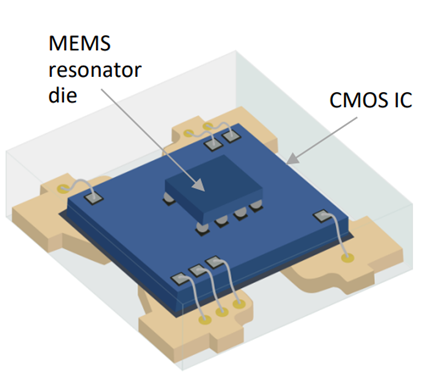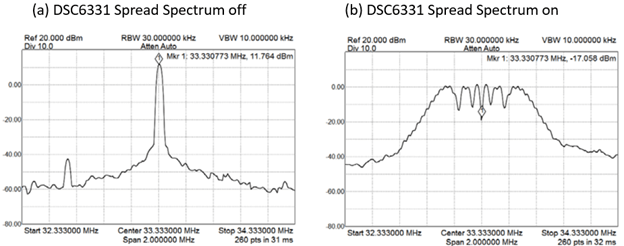Microelectromechanical system (MEMS) technology is leveraging established process advantages afforded by silicon process technology – low cost, precise operation, small size, among others – to replace older technology in numerous devices: pressure sensors, temperature sensors, accelerometers, gyroscopes, even gas detectors and chemical analyzers. You can even add precision clock generators to that expanding list.
All digital devices require a stable reference frequency, a task traditionally performed by quartz oscillators. Early MEMS-based devices had issues with accuracy, stability, and manufacturability that prevented their use in more demanding applications, but manufacturers are developing new products that target these areas.
Recent offerings include ruggedized devices for extreme environments; tiny packages for the most space-constrained uses, and high-performance devices for emerging 5G and IEEE 1588 use. This article will discuss MEMS oscillators in some of these new applications.
MEMS oscillator fundamentals
MEMS technology is the fabrication of miniaturized mechanical and electro-mechanical elements that can vary in size from less than one micrometer to several millimeters. MEMS devices can range from relatively simple structures with no moving parts, to complex electromechanical systems with multiple moving parts.
Fabricating a MEMS device employs many of the same processes used to make other semiconductor circuits: oxidation, diffusion, ion implantation, low pressure chemical vapor deposition (LPCVD), sputtering, and others. MEMS uses specialized processes such as micromachining in addition to these standard techniques.

Figure 1: Schematic of SiTime QFN package with the MEMS die mounted directly on top of the CMOS IC (Image Source: SiTime)
The MEMS oscillator contains a resonator that vibrates under electrostatic or piezoelectric excitation from an analog driver IC. MEMS oscillators can produce frequencies from 1 Hz to hundreds of MHz, with excellent stability and low power consumption. A typical device (Figure 1) consists of a MEMS resonator die stacked on top of the driver chip.
Chip-scale packages accommodate space-constrained portable and wearable applications
For many years, the trend in electronic designs has been to pack ever-increasing functionality into smaller packages. Products are migrating from desktop units to portable and wearable versions of the same equipment. As a result, designers are always searching for smaller implementations of standard functions.
Standard MEMS oscillators are molded into standard low-cost surface-mount device (SMD) plastic packages with footprints as small as 2.0 mm x 1.2 mm, making them ideal for applications that require drop-in compatibility with standard XTAL footprints. To support the demand for even smaller mobile devices, MEMS suppliers are also offering chip-scale packages (CSPs). For example, SiTime’s SiT15xx MEMS oscillators are available in 1.5 mm x 0.8 mm x 0.55 mm (L x W x H) CSPs.
Providing multiple clock outputs from a single device is another space-saving option. The three outputs of Microchip’s DSC613 family, for example, can replace up to three quartz crystals and their driver circuits. The device contains a single resonator and two phase-locked loops (PLLs), giving a large choice of clock configurations.
Portable and wearable products overwhelmingly rely on battery power, so low power consumption is another essential requirement in these applications. Microchip’s DSC6000 series oscillators are designed to serve as clock references in battery-powered wearables and Internet of Things (IoT) devices. The parts feature 1.3 mA current consumption in active mode, and 12 A in standby mode, offer a frequency range from 2 kHz to 8 MHz, and are available in packages as small as 1.6 mm x 1.2 mm.
Ruggedized units for space, automotive standards
Many aerospace, military, and automotive applications require reliable performance under harsh environmental conditions that may include extreme temperatures, shock, and vibration.
The combination of minimal mass and stiff silicon crystal structure renders MEMS oscillators highly resilient and resistant to external stresses. The DSC60XX device discussed above meets the stringent mechanical durability requirements of the automotive AEC-Q100 specification and the shock and vibration immunity standards of MIIL-STD-883.
SiTime has developed a family of ruggedized MEMS oscillators under Endura™ brand that is targeted at aerospace and defense applications. They offer operation over the military temperature range of -55 °C to 155 °C and conform to both MIIL-STD-883 and the MIL-PRF-55310 oscillator specification.
MEMS for high-performance applications
High-speed communications throughout a computer network require precise synchronization between clocks. Synchronous Ethernet (SyncE) and Precision Time Protocol (PTP), defined by IEEE 1588, are two popular synchronization standards.
These standards require the local oscillators in each system to deliver a precise, stable reference, even under changing environmental conditions such changing temperature. Oven-controlled quartz crystal oscillators (OCXO) have been the preferred choice, but they tend to be large and power-hungry.

Figure 2: The SiT5146 Super TCXO combines two MEMS resonators with precision analog circuitry (Image Source: SiTime)
Now high-performance MEMS devices are available to meet these demanding requirements. To do so, they include specialized features such as temperature compensation. SiTime’s Super TXCO devices, for example, incorporate DualMEMSTM technology with two MEMS resonators on a single die. One resonator is designed for a flat frequency response over temperature, and the second resonator acts as an extremely accurate temperature sensor. The resonator and the temperature sensor are closely thermally coupled: only 100 µm separates the two elements. The resonators work together with a highly accurate fractional-N PLL to provide better than 0.1 ppb resolution with extremely low noise.
The MEMS devices consume less power than an equivalent OCXO. As mentioned earlier, a MEMS construction makes oscillators highly resistant to vibration, which can cause lost data in a network or dropped calls in a cellular base station.
MEMS oscillators help to reduce EMI
Packing a greater number of components into a smaller space increases the risks posed of electromagnetic interference (EMI). The high frequencies and fast rise and fall times of the various clock generators on the board are prime contributors to increased EMI.
MEMS oscillators offer two features that help reduce clock-generated EMI. Increasing the rise and fall times of the clock waveforms reduces the energy associated with each clock signal’s harmonic. MEMS oscillators vary the rise and fall times by offering a choice of drive strengths; a lower drive strength increases the time taken to charge a specific load capacitance. Abracon’s ASTMLP oscillator family, for example, offers eight drive strength options that deliver rise times from 3.35 ns to 31.27 ns with a load capacitance CLOAD of 45 pF.
Modulating the clock frequency over time is another EMI reduction technique. The modulation spreads the peak spectral energy of both the fundamental frequency and all the harmonics over a larger frequency range, giving a significant reduction in the energy of the clock harmonics and reducing EMI.
The PLL inside Microchip‘s DSC63xx MEMS oscillator family is modulated with a triangular wave at 33 kHz. The triangular wave is chosen due to its flat spectral density. The DSC63xx offers several modulation options. The spreading can be symmetrically centered on the base clock frequency or vary from the base frequency to a lower value. With center spreading, the output can vary from ±0.25% to ±2.5%, while down spreading gives a variation from –0.25% to –3%. If the clock frequency is 100 MHz, for example, a central spreading value of ±1% will give an output clock from 99 MHz to 101 MHz. If down spreading with –2% is chosen, the output clock will vary from 98 MHz to 100 MHz.

Figure 3: (Image Source: Microchip)
Figure 3 shows the improvement afforded by spread spectrum in the DSC6331. With a 33.333 MHz clock and a central spread of ±1%, the spread spectrum feature provides a reduction in peak power of about 10 dB compared to the performance without spread spectrum.
Online configuration tools meet the need for quick-turn devices
Quick-turn samples can help meet ever-shorter design cycles. Microchip's ClockWorks® Configurator and Sampling Tool is an online configuration tool that helps designers customize oscillators and clock generators for specific application needs. Configurable features include frequency, temperature, ppm and package size; custom samples can be available with 48-hour turnaround time.
SiTime’s Time Machine II is a programming kit complete with software and a USB-powered programmer that allows the configuration and programming of the company’s portfolio of field-programmable oscillators. Following an evaluation of the sample devices, the program can generate a unique part number with the final specifications, then send the data to the factory to make production parts.
Conclusion
MEMS devices have been used for many years in a wide range of applications, thanks to a combination of low cost and high quality. Now MEMS oscillators have begun to replace quartz crystals in some of the most demanding applications.


